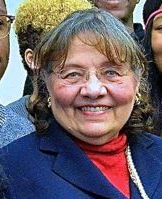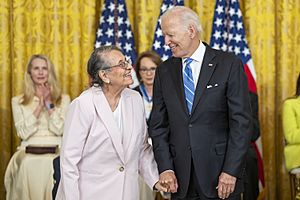Diane Nash facts for kids
Quick facts for kids
Diane Nash
|
|
|---|---|

Nash in 2014
|
|
| Born |
Diane Nash
May 15, 1938 |
| Education | Howard University Fisk University (BA) |
| Organization | Student Nonviolent Coordinating Committee |
| Television | Eyes on the Prize A Force More Powerful Freedom Riders |
| Movement | Civil Rights Movement |
| Spouse(s) | |
| Children | 2 |
| Awards | Presidential Medal of Freedom (2022) Freedom Award |
Diane Judith Nash, born on May 15, 1938, is a brave American civil rights leader. She was a key planner and organizer for young people during the Civil Rights Movement. Her actions helped change many unfair laws.
Nash led some of the most successful efforts of her time. She helped integrate lunch counters in Nashville, meaning Black and white people could eat together. She also played a big part in the Freedom Riders, who worked to end segregation on buses and in travel stations. Nash helped start the Student Nonviolent Coordinating Committee (SNCC). She also began the Alabama Voting Rights Project, which led to the Selma Voting Rights Movement. These efforts were very important for passing the Voting Rights Act of 1965. This law made sure that all Americans, including African Americans, could register and vote freely.
In July 2022, President Joe Biden honored Nash with the Presidential Medal of Freedom. This is one of the highest awards a civilian can receive in the United States.
Diane Nash's Early Life and Activism
Growing Up in Chicago
Diane Nash was born in 1938 in Chicago, Illinois. She grew up in a loving family. Her father, Leon Nash, fought in World War II. Her mother, Dorothy Bolton Nash, worked during the war. Diane spent her early years with her grandmother, Carrie Bolton.
Her grandmother taught Diane to be confident and to know her own worth. Carrie Bolton believed that people learned prejudice from others. She helped Diane feel strong inside. However, this also meant Diane was not fully prepared for the harsh racism she would later see.
Discovering Injustice
Diane went to Catholic schools and thought about becoming a nun. She was also a runner-up in a beauty pageant. After high school, she attended Howard University in Washington, D.C.. This was a historically black college, or HBCU.
After a year, she moved to Fisk University in Nashville, Tennessee. There, she studied English. In Nashville, Diane first truly saw the unfairness of Jim Crow laws. These laws forced Black and white people to be separate. She remembered seeing a "Colored Women" restroom sign at a fair. This was her first direct experience with segregation. Diane was very upset by this injustice. She quickly became a leader and a full-time activist.
Her family was surprised when she joined the Civil Rights Movement. Her grandmother worried she was with "the wrong bunch." But Diane was actually leading nonviolent protests at her university. Her family soon understood her important role. Her mother even helped raise money for the Freedom Riders.
Leading the Nashville Sit-Ins
At Fisk University, Diane looked for ways to fight segregation. She joined workshops led by James Lawson. Lawson taught about nonviolence, inspired by Mahatma Gandhi's methods in India. Diane quickly became one of his best students.
Even though she was shy at first, Diane became a strong leader. She spoke clearly and calmly to officials and the media. In 1960, at age 22, she led the Nashville sit-ins. These protests lasted from February to May. Students would sit at segregated lunch counters and ask for service. They were often refused and sometimes faced harsh treatment. Lawson's workshops prepared them for this, teaching them to respond with love and kindness.
The Nashville sit-ins were special because they were led mostly by college students. These protests spread to many other cities. Diane and other students were finally served at a restaurant in March 1960. They continued to protest and accept arrest without paying bail. In February 1961, Diane went to jail with the "Rock Hill Nine" students. They refused to pay fines for sitting at a whites-only lunch counter. Diane told the judge that paying the fine would support an unfair system.
Diane famously asked Nashville's mayor, Ben West, if he thought it was wrong to discriminate based on race. The mayor agreed it was wrong. Just three weeks later, lunch counters in Nashville began serving Black customers. Diane felt this was a very important turning point.
In August 1961, Diane joined a protest against a supermarket that wouldn't hire Black people. When violence broke out, police arrested many people. Diane insisted on being arrested with other Black protesters and refused to pay bail.
Founding SNCC and Standing Strong
In 1960, many students involved in sit-ins met in North Carolina. The Southern Christian Leadership Conference (SCLC) helped organize this meeting. However, Ella Baker advised the students to form their own group.
In April 1960, Diane Nash helped create the Student Nonviolent Coordinating Committee (SNCC). This group, pronounced "snick," was independent and youth-led. Diane left college to work full-time for SNCC, leading its direct action efforts. SNCC became a powerful voice for young people in the Civil Rights Movement.
Diane was arrested many times for her activism. In February 1961, she spent 30 days in jail in Rock Hill, South Carolina, for protesting segregation. She believed in "jail, no bail," meaning activists would stay in jail to highlight injustice rather than pay to get out.
In 1962, Diane was pregnant with her daughter, Sherri. She faced a two-year prison sentence in Mississippi. This was because she encouraged young people to join the Freedom Riders. Despite her pregnancy, she was ready to serve her time. She wrote an open letter saying she believed going to jail would help her child and all children be free. She served 10 days in jail in Jackson, Mississippi.
Diane also worked with the SCLC, led by Martin Luther King Jr.. She saw herself as an equal partner with King, not just a follower. She later left SCLC because she disagreed with its leadership style. She also left SNCC in 1965 when the group moved away from its core belief in nonviolence.
Leading the Freedom Riders
In 1961, the Congress of Racial Equality (CORE) started the Freedom Riders project. Its goal was to challenge segregation on buses and in travel stations across states. After a bus was attacked and riders were hurt in Birmingham, Alabama, CORE stopped the rides.
Diane Nash declared, "We will not stop." She called on students from Fisk University and other colleges to continue the rides. She believed that if violence stopped their nonviolent efforts, it would send a terrible message. Diane took charge of the Freedom Rides. She recruited new riders, spoke to the media, and sought support. She led the Freedom Riders from Birmingham, Alabama to Jackson, Mississippi.
Even Attorney General Robert F. Kennedy became involved. He worked to keep the rides going. Kennedy's assistant, John Seigenthaler, warned Diane that the rides could be very dangerous. Diane replied, "We cannot let violence overcome nonviolence." She and other students had already prepared for the worst.
To communicate secretly, Diane and activist Fred Shuttlesworth used coded messages about chickens. For example, "roosters" meant male riders and "hens" meant female riders. When Diane called Shuttlesworth to say "The chickens are boxed," he knew the Freedom Riders were on their way.
On May 20, 1961, riders left Birmingham for Montgomery. They were promised protection, but it disappeared. A violent mob attacked the riders with pipes and bricks. Many, including John Seigenthaler, were hurt.
The next day, Martin Luther King Jr. came to the First Baptist Church in Montgomery. Diane played a key role in getting him to speak. Over 1,500 people were trapped inside the church as violence raged outside. The governor declared martial law to stop the mob. King told the crowd to "remain calm" and "continue to stand up for what we know is right."
In 1963, President John F. Kennedy asked Nash to join a committee. This committee worked on new civil rights laws. These efforts led to the Civil Rights Act of 1964.
Fighting for Voting Rights
Diane Nash was deeply affected by a church bombing in Birmingham in 1963. Four young girls died in the attack. She and James Bevel decided to create a nonviolent plan to help Black adults in Alabama get the right to vote. At that time, many Black people in the South were prevented from voting.
Diane and Bevel, working with SCLC, organized the Selma to Montgomery marches in 1965. These protests were for voting rights in Alabama. Marchers crossed the Edmund Pettus Bridge but were attacked by police with clubs and tear gas. John Lewis was badly hurt. These shocking images were shown on national television.
Soon after, President Lyndon Johnson said it was "wrong" to deny Americans the right to vote. These efforts led to the 1965 Voting Rights Act. This law allowed the federal government to make sure everyone could register and vote.
In 1965, SCLC gave its highest honor, the Rosa Parks Award, to Diane Nash and James Bevel. This was for their leadership in the Alabama Project and the Selma Voting Rights Movement.
Later Life and Recognition
Honoring a Civil Rights Hero
For many years, male leaders received most of the credit for the Civil Rights Movement's successes. However, historians now fully recognize Diane Nash's important contributions.
In 1995, historian David Halberstam called Nash "bright, focused, utterly fearless." He said her leadership instincts were perfect. She inspired others to be their best.
Nash has been featured in documentaries like Eyes on the Prize and A Force More Powerful. She also appeared in the PBS American Experience film about the Freedom Riders. Her work is also highlighted in books like The Children and Diane Nash: The Fire of the Civil Rights Movement.
She has received many awards, including the Distinguished American Award from the John F. Kennedy Library (2003). She also received the LBJ Award for Leadership in Civil Rights (2004).
Diane Nash still believes in the power of nonviolent action to solve problems. She once said that the Civil Rights Movement showed how to resolve human conflicts. She hopes countries will talk and negotiate instead of going to war.
In December 2021, the city of Nashville named the area in front of its courthouse the Diane Nash Plaza. This is where she famously confronted Mayor West about segregated lunch counters.
On July 1, 2022, the White House announced that Nash would receive the Presidential Medal of Freedom.
Life After the Movement
After the Civil Rights Movement, Diane Nash moved back to Chicago. She worked in education and real estate. She continued to support causes like fair housing and anti-war efforts. She still lives in Chicago and remains close to her son, Douglass Bevel.
In 2013, Nash supported Barack Obama as president. However, she also shared her concerns about wars. She believes that real change in America comes from its citizens, not just government officials.
In March 2015, Diane attended the 50th anniversary of the Selma marches. But she chose not to participate in the re-enactment of the march. She disagreed with the presence of former president George W. Bush. Nash, who dedicated her life to peace, felt his policies were against nonviolence.
Decades later, Diane Nash remains committed to the principles of nonviolence. She played a huge role in many successful civil rights efforts. Yet, she stays humble. She remembers the "many thousands of people" whose names we will never know, who also made sacrifices for change.
Personal Life
Diane Nash met James Bevel during the Nashville sit-ins. They later married and had two children, a son and a daughter. The couple divorced after seven years. Diane Nash never remarried.
See also


